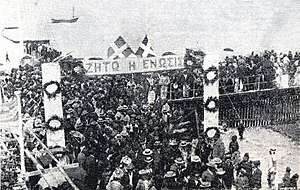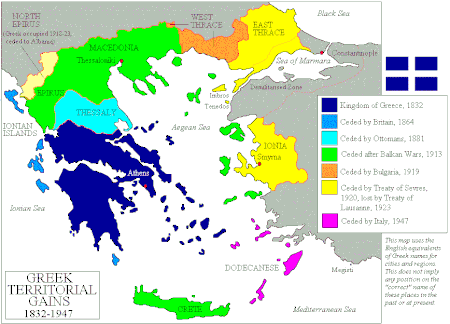Enosis
Enosis (Greek: Ένωσις, IPA: [ˈenosis], "union") is the movement of various Greek communities that live outside Greece, for incorporation of the regions they inhabit into the Greek state. The idea of enosis is related to the Megali Idea, an irredentist concept of a Greek state which dominated Greek politics following the creation of the modern Greek state in 1830. The Megali Idea was a project which called for the annexation of all ethnic Greek lands, parts of which had participated in the Greek War of Independence in the 1820s but which were unsuccessful and remained under foreign rule.

A widely known example of enosis is the movement within the Greek-Cypriot community for a union of Cyprus into Greece. The idea of enosis in British-ruled Cyprus became associated with the campaign for Cypriot self-determination, especially among the island's Greek Cypriot majority. However, many within the Turkish Cypriot population opposed enosis without taksim (the partitioning of the island between Greek Cypriots and Turkish Cypriots). In 1960, the Republic of Cyprus was born, but this did not result either in enosis nor taksim. Around this time, Cypriot intercommunal violence was occurring in response to the different objectives, and the continuing desire for enosis resulted in the 1974 Cypriot coup d'état in an attempt to achieve it. This, however, prompted Turkey into launching the Turkish invasion of Cyprus, leading to partition and the current Cyprus dispute.
History

The boundaries of the Kingdom of Greece were originally established at the London Conference of 1832[1] following the Greek War of Independence.[2] The Duke of Wellington wanted the new state to be limited to the Peloponnese[3] because Britain wished to preserve as much of the territorial integrity of the Ottoman Empire as possible. The initial Greek state included little more than the Peloponnese, Attica and the Cyclades. Its population amounted to less than 1 million with three times as many ethnic Greeks living outside it, mainly in Ottoman territory.[4] Some of these aspired to be incorporated in the kingdom, and movements among them calling for enosis, or union with Greece, often achieved popular support. As the Ottoman Empire declined, the Greek state expanded with a number of territorial gains.
The Ionian Islands had been placed under British protection as a result of the Treaty of Paris in 1815, but once Greek independence was established after 1830 the islanders began to resent foreign colonial rule and to press for enosis. Britain transferred the islands to Greece in 1864.
Thessaly remained under Ottoman control after the formation of the Kingdom of Greece. Although parts of the territory had participated in the initial uprisings in the Greek War of Independence in 1821, the revolts had been swiftly crushed. During the Russo-Turkish War of 1877–78 Greece remained neutral, as a result of assurances by the Great Powers that her territorial claims on the Ottoman Empire would be considered after the war. In 1881 Greece and the Ottoman Empire signed the Convention of Constantinople which created a new Greco-Turkish border, incorporating most of Thessaly into Greece.
Crete rebelled against Ottoman rule during the Cretan Revolt of 1866-69 using the motto "Crete, Enosis, Freedom or Death". The Cretan State was established following the intervention of the Great Powers, and Cretan union with Greece occurred de facto in 1908 and de jure in 1913 through the Treaty of Bucharest.
An unsuccessful Greek uprising in Macedonia against Ottoman rule had taken place during the Greek War of Independence. There was a rebellion in 1854 aiming to unite Macedonia with Greece, but it failed.[5] The Treaty of San Stefano in 1878 following the Russo-Turkish War of 1877–1878 awarded nearly all of Macedonia to Bulgaria. This resulted in the 1878 Greek Macedonian rebellion and the reversal of the award at the Treaty of Berlin (1878), leaving the territory in Ottoman hands. There followed the protracted Macedonian Struggle between Greeks and Bulgarians in the region, the resultant guerrilla war only coming to an end with the Ottoman revolution of Young Turks in July 1908. Bulgarian and Greek rivalries over Macedonia became part of the Balkan Wars of 1912–13, with the 1913 Treaty of Bucharest awarding Greece large parts of Macedonia, including Thessaloniki. The Treaty of London (1913) awarded southern Epirus to Greece, the Epirus region having risen up against Ottoman rule during the Epirus Revolt of 1854 and the Epirus Revolt of 1878.
In 1821, several parts of Western Thrace rebelled against Ottoman rule, participating in the Greek War of Independence. During the Balkan Wars, Western Thrace was occupied by Bulgarian troops and in 1913 Bulgaria gained Western Thrace under the terms of the Treaty of Bucharest. Following World War I, Western Thrace was withdrawn from Bulgaria under the terms of the 1919 Treaty of Neuilly and put temporarily under Allied management before being given to Greece at the San Remo conference in 1920.
Following the conclusion of World War I, Greece began the occupation of Smyrna and surrounding areas of Western Anatolia in 1919 at the invitation of the victorious Allies of World War I, particularly David Lloyd George the British Prime Minister. The occupation was given official status in the 1920 Treaty of Sèvres, with Greece being awarded most of Eastern Thrace and a mandate to govern Smyrna and its hinterland.[6] Smyrna was declared a protectorate in 1922. However, the attempted enosis failed when the new Turkish Republic prevailed in the resulting Greco-Turkish War of 1919–1922, after which most Anatolian Christians who had not already fled during the war were forced to relocate to Greece in the 1923 population exchange between Greece and Turkey.
Most of the Dodecanese islands were slated to become part of the new Greek state in the London Protocol of 1828, but when Greek independence was recognised in the London Protocol of 1830, the islands were left outside the new Kingdom of Greece. They were subsequently occupied by Italy in 1912 and held until World War II, after which they became a British military protectorate. The islands were formally united with Greece by the 1947 Treaty of Peace with Italy, despite objections from Turkey which also desired them.
The Autonomous Republic of Northern Epirus was proclaimed in 1914 by ethnic Greeks in Northern Epirus, the area having been incorporated into Albania following the Balkan Wars. Greece held the area between 1914 and 1916 and unsuccessfully tried to annex it in March 1916,[7] but in 1917 Greek forces were driven from the area by Italy, who took over most of Albania.[8] The Paris Peace Conference of 1919 awarded the area to Greece, but following Greece's defeat in the Greco-Turkish War the area reverted to Albanian control.[9] Following Italy's invasion of Greece from the territory of Albania in 1940 and the successful Greek counterattack, the Greek army briefly held Northern Epirus for a six-month period until the German invasion of Greece in 1941. Tensions between Greece and Albania remained high during the Cold War, but relations began to improve in the 1980s with Greece's abandonment of any territorial claims over Northern Epirus and the lifting of the official state of war between the two countries.[7] In modern times, apart from Cyprus, the call for enosis is most often heard among part of the Greek community living in southern Albania.[10]
Cyprus
Inception of Cypriot enosis
In 1828, modern Greece’s first president Ioannis Kapodistrias called for union of Cyprus with Greece, and numerous minor uprisings took place.[11] Cyprus was at that time part of the Ottoman Empire. In 1878 Cyprus was occupied by the British, who annexed it in 1914.
The death of Limassol–Paphos MP Christodoulos Sozos during the course of the Battle of Bizani ([[First Balkan War) left a lasting mark on the Enosis movement, being one of its most important events before the 1931 Cyprus revolt. Greek schools and courts suspended their activities, a court in Nicosia also raised a flag in honor of Sozos thus breaking the law as Britain maintained a neutral stance in the conflict. Mnemosyna were held in dozens of villages across Cyprus, as well as in Cypriot communities in Athens, Egypt and Sudan. Greek Cypriot newspapers were swept with nationalist fervor comparing Sozos with Pavlos Melas. A photo of Sozos was placed in the Hellenic Parliament.[12] [13]
Britain offered to cede the island to Greece in 1915 in return for Greece joining the allies in World War I, but the offer was refused.[14]
The enosis movement was the outgrowth of nationalist awareness among the ethnically Greek population of Cyprus (around 80%[15] between 1882 and 1960), coupled with the growth of the anti-colonial movement throughout the British Empire after World War II. In fact, the anti-colonial movement in Cyprus was identified with the enosist movement, enosis being, in the minds of the Hellenic population of Cyprus, the only natural outcome of the liberation of the Cypriot people from Ottoman rule and later the British rule. A string of British proposals for local autonomy under continued British suzerainty were roundly rejected.
In 1929 a Greek Cypriot delegation was sent to London to request enosis but received a negative response.[16] Following anti-British riots in 1931 the desire for self-government within the British Commonwealth developed but the movement for enosis became dominant.[17]
1940s and 1950s
During the 1950s the influence of the Greek Orthodox Church of Cyprus over the education system resulted in ideas of Greek nationalism and enosis being promoted in Greek Cypriot schools. School textbooks portrayed Turks as enemies of Greeks and students took an oath of allegiance to the Greek flag. The British authorities attempted to counter this by publishing an inter-communal periodical for students and suspending the Cyprus Scouts Association for its Greek nationalist tendencies.[18]
In December 1949, the Cypriot Orthodox Church asked the British colonial government to put the enosis question to a referendum, on the basis of the right of the Cypriot population for self-determination. Even though the UK was an ally of Greece during WW2 and had recently supported the Greek government during the Greek civil war, the British colonial government refused.
In 1950 Archbishop Spyridon of Athens led the call for Cypriot enosis in Greece.[19] The Church was a strong supporter of enosis and organised a plebiscite, the Cypriot enosis referendum, which was held on 15 and 22 January 1950. Open books were placed in churches for those over 18 to sign and indicate whether they supported or opposed enosis. The majority in support of enosis was 95.7%.[20][21] Later, there were accusations that the local Greek Orthodox church had told its congregation that if it did not vote in favour of enosis that would have meant excommunication from the church.[22][23]
After the referendum, a Greek Cypriot deputation visited Greece, Britain and the United Nations to make their case, while Turkish Cypriots and student and youth organisations in Turkey protested against the plebiscite. In the event neither Britain nor the UN were persuaded to support enosis.[24] In 1951 a report was produced by the British government's Smaller Territories Enquiry into the future of the British Empire's smaller territories, including Cyprus. It concluded that Cyprus should never be independent from Britain. This view was strengthened by Britain's withdrawal of its Suez Canal base in 1954 and the transfer of its Middle East Headquarters to Cyprus.[14] In 1954, Greece made its first formal request to the UN for the implementation of "the principle of equal rights and of self-determination of the peoples" in the case of the Cypriot population. Until 1958, four other relative requests were made- unsuccessfully- by the Greek government to the United Nations.[25]
In 1955, the resistance organisation EOKA started a campaign against British rule to bring about enosis with Greece. The campaign lasted until 1959.[24] By then, it was argued by many that enosis was politically unfeasible due to the presence of a strong Turkish minority and its increasing assertiveness. Instead, the creation of an independent state with elaborate power-sharing arrangements among the two communities was agreed upon in 1960, and the fragile Republic of Cyprus was born.
After independence
The idea of union with Greece was not immediately abandoned, though. During the campaign for the 1968 presidential elections, the incumbent President Makarios III said that enosis was "desirable" whereas independence was "possible".
At the start of the 1970s, the idea of enosis remained attractive to many Greek Cypriots, and Greek Cypriot students condemned President Makarios's support for an independent unitary state. In 1971 the pro-enosis paramilitary group EOKA B was formed and Makarios declared his opposition to the use of violence to achieve enosis. EOKA B began a series of attacks against the Makarios government and in 1974 the Cypriot National Guard organised a military coup against Makarios, supported by the Greek government under the control of the Greek military junta of 1967–1974. Rauf Denktaş, the Turkish Cypriot leader, called for military intervention by the UK and Turkey to prevent enosis. Turkey acted unilaterally and the Turkish invasion of Cyprus occupied Northern Cyprus.[17]
The result of the events of 1974 was the geographic partition of Cyprus, followed by massive population transfers. The coup and subsequent events seriously undermined the enosis movement. The departure of Turkish Cypriots from the areas which remained under the Republic's effective control resulted in a homogeneous Greek Cypriot society in the southern two-thirds of the island. The remaining third of the island is increasingly colonised by Turks.
In 2017 the Cypriot Parliament passed a law allowing for the celebration of the 1950 Cypriot enosis referendum in Greek Cypriot public schools.[26]
See also
- Miatsum
- Taksim
- Greek nationalism
- Anti-Turkism
References
- "On This Day In History: Independence Of Greece Is Recognized By The Treaty Of London – On May 7, 1832". Ancient Pages. 7 May 2016.
- Anagnostopoulos, Nikodemos (2017). Orthodoxy and Islam: Theology and Muslim–Christian Relations in Modern Greece and Turkey. Routledge. ISBN 9781315297910.
- Cooke, Tim (2010). The New Cultural Atlas of the Greek World. Marshall Cavendish. p. 174. ISBN 9780761478782.
- Hupchick, D (2002). The Balkans: From Constantinople to Communism. Springer. p. 223. ISBN 9780312299132.
- Reid, James J. (2000). Crisis of the Ottoman Empire: prelude to collapse, 1839-1878. Franz Steiner Verlag. pp. 249–252. ISBN 9783515076876.
- Frucht, Richard. Eastern Europe. Volume 2. p. 888. ISBN 9781576078006.
- Konidaris, Gerasimos (2005). Schwandner-Sievers, Stephanie (ed.). The new Albanian migrations. Sussex Academic Publishing. p. 66. ISBN 9781903900789.
- Tucker, Spencer; Roberts, Priscilla Mary (2005). World War I: encyclopedia. ABC-CLIO. p. 77. ISBN 978-1-85109-420-2. Retrieved 26 January 2011.
- Miller, William (1966). The Ottoman Empire and Its Successors, 1801-1927. Routledge. pp. 543–544. ISBN 978-0-7146-1974-3.
- Stein, Jonathan (2000). The politics of national minority participation in post-communist Europe : state-building, democracy, and ethnic mobilization. Armonk, N.Y.: Sharpe. p. 180. ISBN 9780765605283.
- William Mallinson, Bill Mallinson (2005). Cyprus: a modern history. I.B.Tauris. p. 10. ISBN 9781850435808.
ISBN 1-85043-580-4" "In 1828, modern Greece’s first president, Count Kapodistria, called for union of Cyprus with Greece, and various minor uprising took place.
- Papapolyviou 1996, pp. 186–193, 340.
- Klapsis 2013, pp. 765–767.
- McIntyre, W. David (2014). Winding Up the British Empire in the Pacific Islands. Oxford History of the British Empire. OUP. p. 72. ISBN 9780198702436.
- "Cyprus - Population". Country-data.com. Retrieved 2011-01-05.
- Goktepe, Cihat (2013). British Foreign Policy Towards Turkey, 1959-1965. Routledge. p. 92. ISBN 9781135294144.
- The Middle East and North Africa 2003. Regional surveys of the world (49th ed.). Psychology Press. 2002. p. 242–5. ISBN 9781857431322.
- Lange, Matthew (2011). Educations in Ethnic Violence: Identity, Educational Bubbles, and Resource Mobilization. Cambridge University Press. pp. 101–5. ISBN 1139505440.
- Stephanidēs, Giannēs D. (2007). Stirring the Greek Nation: Political Culture, Irredentism and Anti-Americanism in Post-war Greece, 1945-1967. Ashgate Publishing. p. 109. ISBN 9780754660590.
- Goktepe 2013, pp. 92–3.
- Zypern, 22. Januar 1950 : Anschluss an Griechenland Direct Democracy
- "ΕΝΩΤΙΚΟ ΔΗΜΟΨΗΦΙΣΜΑ 15-22/1/1950 (in Greek, includes image of a signature page)". Cyprus.novopress.info. Archived from the original on 2011-07-21. Retrieved 2011-01-05.
- "Κύπρος: το ενωτικό δημοψήφισμα που έγινε με υπογραφές (in Greek)". Hellas.org. 1967-04-21. Archived from the original on 3 March 2001. Retrieved 2011-01-05.
- Goktepe 2013, p. 93.
- Emis i Ellines- Polemiki istoria tis Synhronis Elladas ("Greeks- War History of Modern Greece"), Skai Vivlio press, 2008, chapter by nikos Papanastasiou "The Cypriot Issue", p. 125, 142
- "Turkey slams Greek Cyprus' Enosis move". Hürriyet Daily News. 15 February 2017. Retrieved 10 January 2018.
Sources
- Klapsis, Antonis (2009). "Between the Hammer and the Anvil. The Cyprus Question and the Greek Foreign Policy from the Treaty of Lausanne to the 1931 Revolt". Modern Greek Studies Yearbook. University of Minnesota. 24: 127–140. Retrieved 26 May 2017.CS1 maint: ref=harv (link)
- Papapolyviou, Petros (1996). "Η Κύπρος και οι Βαλκανικοί Πόλεμοι: Συμβολή στην Ιστορία του Κυπριακού Εθελοντισμού" [Cyprus and the Balkan Wars: A Contribution to the History of Cypriot Volunteerism]. Aristotle University of Thessaloniki Thesis (in Greek). Aristotle University of Thessaloniki: 1–407. Retrieved 6 September 2017.CS1 maint: ref=harv (link)


